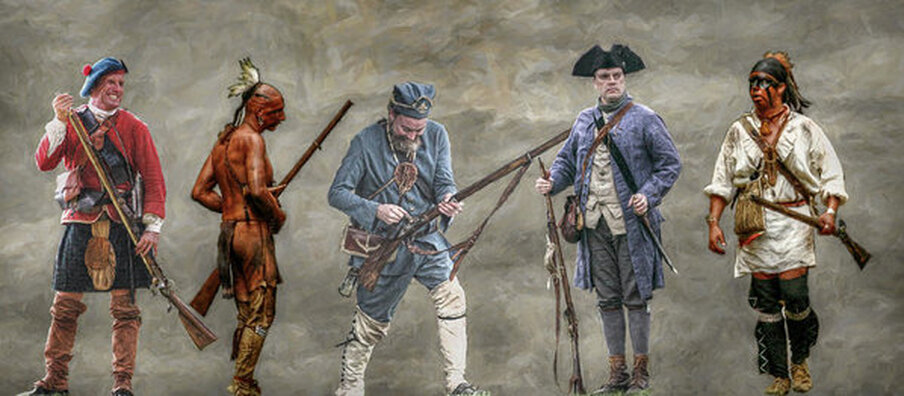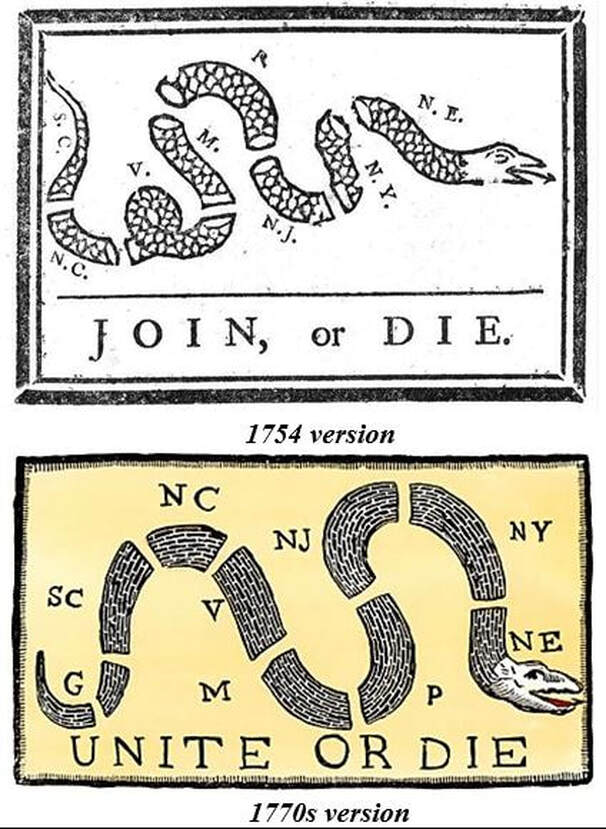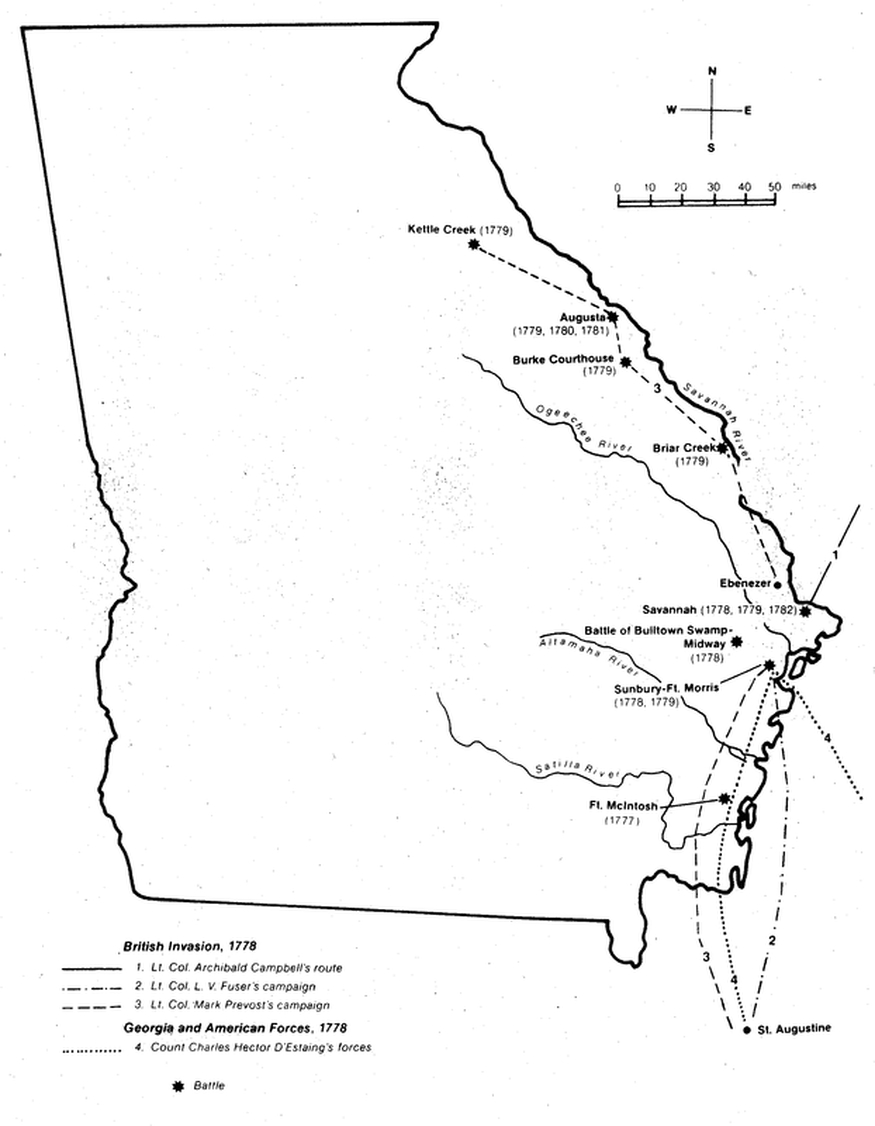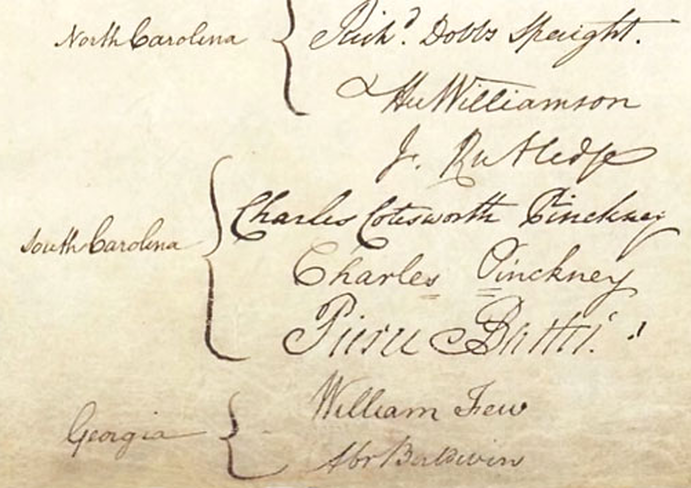Unit 4- The American Revolution in Georgia
SS8H3- Analyze the role of Georgia in the American Revolutionary Era.
A. Explain the causes of the American Revolution as they impacted Georgia; include the French and Indian War, Proclamation of 1763, and the Stamp Act.
B. Interpret the three parts of the Declaration of Independence (preamble, grievances, and declaration) and identify the three Georgia signers of the document.
C. Analyze the significance of the Loyalists and Patriots as a part of Georgia’s role in the Revolutionary War; include the Battle of Kettle Creek and Siege of Savannah.
D. Analyze the weaknesses of the Articles of Confederation and explain how those weaknesses led to the writing of a new federal Constitution.
A. Explain the causes of the American Revolution as they impacted Georgia; include the French and Indian War, Proclamation of 1763, and the Stamp Act.
B. Interpret the three parts of the Declaration of Independence (preamble, grievances, and declaration) and identify the three Georgia signers of the document.
C. Analyze the significance of the Loyalists and Patriots as a part of Georgia’s role in the Revolutionary War; include the Battle of Kettle Creek and Siege of Savannah.
D. Analyze the weaknesses of the Articles of Confederation and explain how those weaknesses led to the writing of a new federal Constitution.
Causes of the American Revolution
The French and Indian War (sometimes called the Seven Years' War) changed the relationship between Great Britain and its North American colonies in ways that neither could foresee. The war against the French had been expensive for Great Britain, and the country was already in a debt crisis from previous wars. The British government needed money. It thought that, since the war had started as a way to help the colonies, the Americans should be willing to help pay for it and their continued defense. So, the first effect of the war was that Parliament began a policy of taxing the colonies in order to raise money. In the past, colonial assemblies, not Parliament, determined the taxes to pay for colonial expenses. This new policy caused major problems and "No taxation without representation" became a rally cry.
Taxes implemented on the colonists:
Sugar Act (1764) was a tax on sugar and molasses imported from the West Indies. This act also called for more customs officials to oversee the goods coming into the ports from overseas to ensure the taxes were being paid.
Stamp Act (1765) was a direct tax that required all printed materials and documents to have a tax stamp. Examples of taxable items included legal documents, newspapers, licenses, and even playing cards.
Townshend Act (1767) place import taxes on tea, coffee, wine, glass, lead, paper, glass and other items.
Tea Act (1773) gave one company, the East India Company, a monopoly to sell tea in the colonies. This was a ploy to get colonists to buy their cheap tea to keep the company from going bankrupt...many colonist felt this was a trick and the tea was being forced upon them.
Another sticking point was the Proclaimation of 1763. The Proclamation of 1763 was issued by King George III and forbade colonists from settling lands west of the Appalachian Mountains. The Proclamation was issued in order to stabilize relations between Great Britain and the American Indian tribes who lived in the river valley. Because the British were virtually bankrupt from the Seven Years War, they could not afford to fight another costly war with the American Indians over territory. However, the colonists, many of whom participated in the war in hopes of gaining new western lands, were extremely upset by the Proclamation of 1763. In fact, many colonists simply ignored the Proclamation and settled in the river valley anyway
Sugar Act (1764) was a tax on sugar and molasses imported from the West Indies. This act also called for more customs officials to oversee the goods coming into the ports from overseas to ensure the taxes were being paid.
Stamp Act (1765) was a direct tax that required all printed materials and documents to have a tax stamp. Examples of taxable items included legal documents, newspapers, licenses, and even playing cards.
Townshend Act (1767) place import taxes on tea, coffee, wine, glass, lead, paper, glass and other items.
Tea Act (1773) gave one company, the East India Company, a monopoly to sell tea in the colonies. This was a ploy to get colonists to buy their cheap tea to keep the company from going bankrupt...many colonist felt this was a trick and the tea was being forced upon them.
Another sticking point was the Proclaimation of 1763. The Proclamation of 1763 was issued by King George III and forbade colonists from settling lands west of the Appalachian Mountains. The Proclamation was issued in order to stabilize relations between Great Britain and the American Indian tribes who lived in the river valley. Because the British were virtually bankrupt from the Seven Years War, they could not afford to fight another costly war with the American Indians over territory. However, the colonists, many of whom participated in the war in hopes of gaining new western lands, were extremely upset by the Proclamation of 1763. In fact, many colonists simply ignored the Proclamation and settled in the river valley anyway
Socratic Seminar for Unit 4: Revolutionary Cartoons
The Bloody Massacre perpetrated in King Street Boston on March 5th 1770, by a party of the 29thRegt.
by Paul Revere, March 28, 1770 (copied from Henry Pelham)
by Paul Revere, March 28, 1770 (copied from Henry Pelham)
"Join, or Die" in the The Philadephia Gazette, May 9, 1754 by Benjamin Franklin
"Unite or Die" in the New-York Journal; or, the General Advertiser, June 24, 1774 by John Holt
"Unite or Die" in the New-York Journal; or, the General Advertiser, June 24, 1774 by John Holt
THE BOSTONIANS Paying the EXCISE MAN, or TARRING and FEATHERING by Philip Dawe, 1774
The Declaration of Independence
The Declaration of Independence was the document officially declaring the colonies’ independence from Great Britain. It was adopted by the Continental Congress on July 4, 1776. The declaration was drafted by Thomas Jefferson.
The Declaration of Independence is a document that is divided into three parts. The first part, the Preamble, explains to the reader about the natural rights of all people (though this has been debated), states the reasons for the document, and includes the famous quote “We hold these truths to be self-evident that all men are created equal, that they are endowed by their creator with certain unalienable Rights, that among these are life, liberty, and the pursuit of happiness.”
The second part includes a list of grievances against King George III including “imposing taxes without our consent” and “quartering large bodies of troops among us.” The list details why the colonies deemed independence necessary.
The final part is the actual “declaration of independence” and is where the colonists officially severed ties from Great Britain, the mother country.
The second part includes a list of grievances against King George III including “imposing taxes without our consent” and “quartering large bodies of troops among us.” The list details why the colonies deemed independence necessary.
The final part is the actual “declaration of independence” and is where the colonists officially severed ties from Great Britain, the mother country.
Three Georgians, Button Gwinnett, Lyman Hall, and George Walton, attended the Second Continental Congress and signed the Declaration of Independence on behalf of the Georgia colony.
The Revolution in Georgia
*Georgia was much younger than the other American colonies and didn’t have a long history of self-government. Also, along the coast a number of Georgians had become wealthy from trade
with Great Britain. Under the royal governor, Sir James Wright, the colony had grown and prospered. Thus, when northern colonies began pushing for freedom from Britain, Georgia was not quick to join in.
*Loyalty to Great Britain was strongest in coastal Georgia. Far in land, backcountry Georgians were far more likely to want independence. However, even in coastal Georgia, support of the mother country began to weaken. Georgians soon began to take sides. As in the oth er colonies, anti-British Georgians were known as Whigs and later as “patriots.” Supporters of Britain were called Tories or “loyalists.”
with Great Britain. Under the royal governor, Sir James Wright, the colony had grown and prospered. Thus, when northern colonies began pushing for freedom from Britain, Georgia was not quick to join in.
*Loyalty to Great Britain was strongest in coastal Georgia. Far in land, backcountry Georgians were far more likely to want independence. However, even in coastal Georgia, support of the mother country began to weaken. Georgians soon began to take sides. As in the oth er colonies, anti-British Georgians were known as Whigs and later as “patriots.” Supporters of Britain were called Tories or “loyalists.”
Fighting in the Backcountry: America's First Civil War

Battle of Kettle Creek
On February 14, 1779 a major battle took place in the backcountry in Wilkes County. Carolina loyalist Col. James Boyd and his men camped near Kettle Creek on February 13. Boyd planned to leave the next morning for British-held Augusta. The next day, however, Patriot militia led by Andrew Pickens, Elijah Clark used the element of surprise to attack the camp. Pickens and his men attacked Boyd's camp head on. Clarke and Dooly used flanking movements and attacked the rear cutting off the escape of the Loyalists. The smaller force of the Patriots defeated the 600-man Loyalist forces. Boyd and many of his men were killed, and many others were captured. Only 250 of Boyd's men managed to escape the attack.
Results:
1. The Patriot militia was able to capture badly needed weapons and horses from the Loyalists.
2. The spirits of Georgia militia was lifted by their victory. Additionally, their victory won over many Georgians who had wavered in their support of the war.
3. The victory also ensured that the backcountry remained in Patriot control.
On February 14, 1779 a major battle took place in the backcountry in Wilkes County. Carolina loyalist Col. James Boyd and his men camped near Kettle Creek on February 13. Boyd planned to leave the next morning for British-held Augusta. The next day, however, Patriot militia led by Andrew Pickens, Elijah Clark used the element of surprise to attack the camp. Pickens and his men attacked Boyd's camp head on. Clarke and Dooly used flanking movements and attacked the rear cutting off the escape of the Loyalists. The smaller force of the Patriots defeated the 600-man Loyalist forces. Boyd and many of his men were killed, and many others were captured. Only 250 of Boyd's men managed to escape the attack.
Results:
1. The Patriot militia was able to capture badly needed weapons and horses from the Loyalists.
2. The spirits of Georgia militia was lifted by their victory. Additionally, their victory won over many Georgians who had wavered in their support of the war.
3. The victory also ensured that the backcountry remained in Patriot control.
The Siege of Savannah: October 1779
In 1778, British policymakers and strategists decided to refocus their efforts on the southern colonies, where they believed the crown would enjoy the support of a large Loyalist population. As part of that effort, a British army under Lieutenant Colonel Archibald Campbell captured the city of Savannah, Georgia on December 29, 1778.
In the fall of 1779, the Americans were determined to take the city back. American forces in the region, numbering between 5,000 and 7,000 men, were based in Charleston, South Carolina, under the command of General Benjamin Lincoln. Lincoln recognized that to recapture Savannah, he would need assistance from the French military. On September 3, he learned that Charles Hector, Comte d’Estaing, was en-route to Savannah, bringing with him a fleet of warships and 4,000 French soldiers.
On September 11, Lincoln left Charleston with a force of his own, intent on linking up with d’Estaing. Arriving first, d’Estaing began offensive operations against the city on September 16. When fully assembled, the Allied force numbered over 5,000 men. Defending Savannah was a force of more than 3,000 men under the command of General Augustine Prevost.
On the morning of October 9, the Franco-American Allies launched a major assault. Fog shrouded the battlefield, impeding forward progress. Troops became lost in the swamps fronting the Spring Hill Redoubt, the Allied objective. d’Estaing had selected the Spring Hill Redoubt under the mistaken impression that it was lightly defended by local Loyalist militia. In reality, the Loyalist militia was backed by battle-hardened British Regulars. When the fog lifted, the French lines were fully exposed, crumbling in the face of a withering and incessant fire from the redoubt’s defenders. d’Estaing himself was wounded twice while personally leading the attack. Mortally wounded in the assault was the Polish cavalry mastermind, Casimir Pulaski, who had done much to shape the mounted forces of the Continental Army. He was shot while trying to lead his horseman through a temporary breach in the British line. During the attack on the Spring Hill Redoubt, the Allies lost roughly 1,000 men. The British suffered only 150 casualties.
An hour after leading his forces forward, d’Estaing called off the attack, recognizing its futility. A week later the French commander sailed away, leaving Lincoln behind and the Franco-American Alliance strained.
On October 19, Lincoln lifted the siege. Savannah would remain in British hands until the end of the war.
In the fall of 1779, the Americans were determined to take the city back. American forces in the region, numbering between 5,000 and 7,000 men, were based in Charleston, South Carolina, under the command of General Benjamin Lincoln. Lincoln recognized that to recapture Savannah, he would need assistance from the French military. On September 3, he learned that Charles Hector, Comte d’Estaing, was en-route to Savannah, bringing with him a fleet of warships and 4,000 French soldiers.
On September 11, Lincoln left Charleston with a force of his own, intent on linking up with d’Estaing. Arriving first, d’Estaing began offensive operations against the city on September 16. When fully assembled, the Allied force numbered over 5,000 men. Defending Savannah was a force of more than 3,000 men under the command of General Augustine Prevost.
On the morning of October 9, the Franco-American Allies launched a major assault. Fog shrouded the battlefield, impeding forward progress. Troops became lost in the swamps fronting the Spring Hill Redoubt, the Allied objective. d’Estaing had selected the Spring Hill Redoubt under the mistaken impression that it was lightly defended by local Loyalist militia. In reality, the Loyalist militia was backed by battle-hardened British Regulars. When the fog lifted, the French lines were fully exposed, crumbling in the face of a withering and incessant fire from the redoubt’s defenders. d’Estaing himself was wounded twice while personally leading the attack. Mortally wounded in the assault was the Polish cavalry mastermind, Casimir Pulaski, who had done much to shape the mounted forces of the Continental Army. He was shot while trying to lead his horseman through a temporary breach in the British line. During the attack on the Spring Hill Redoubt, the Allies lost roughly 1,000 men. The British suffered only 150 casualties.
An hour after leading his forces forward, d’Estaing called off the attack, recognizing its futility. A week later the French commander sailed away, leaving Lincoln behind and the Franco-American Alliance strained.
On October 19, Lincoln lifted the siege. Savannah would remain in British hands until the end of the war.
Articles of Confederation/ U.S. Constitution
The Articles of Confederation served as America's constitution from 1776-1779 and provided the country with an extremely weak central government. This stems from the Americans’ experience with Britain’s monarchy and their goal to give as much power as they could to the “people” through the autonomy of the states. Regardless, the Articles were inadaquate to govern the country smoothly.
Some of the powers the national government had under the Articles of Confederation:
• Declare war;
• Coin money;
• Establish post offices; and
• Send and recall Ambassadors.
Some of the powers the national government did not have under the Articles of Confederation:
• Levy (impose) taxes to fund the government (the national government had to ask states for support); and, • Could not regulate the trade of goods between the states (states could place tariffs on each other).
Some of the more serious weaknesses of the articles included:
• A strong legislative branch and no executive or judicial branches;
• Each state had its own currency;
• A unanimous vote of all 13 states was required for the Articles to be amended; and,
• One vote per state no matter the size of the state’s population.
Some of the powers the national government had under the Articles of Confederation:
• Declare war;
• Coin money;
• Establish post offices; and
• Send and recall Ambassadors.
Some of the powers the national government did not have under the Articles of Confederation:
• Levy (impose) taxes to fund the government (the national government had to ask states for support); and, • Could not regulate the trade of goods between the states (states could place tariffs on each other).
Some of the more serious weaknesses of the articles included:
• A strong legislative branch and no executive or judicial branches;
• Each state had its own currency;
• A unanimous vote of all 13 states was required for the Articles to be amended; and,
• One vote per state no matter the size of the state’s population.
(left) Few, William ((1748-1828) - Georgia signer of the U.S. Constitution; was also a judge and legislator for Georgia and New York.
(right) Baldwin, Abraham (1754-1807) - Georgia signer of the U.S. Constitution; also a U.S. Congressman, U.S. Senator, and the first president of the University of Georgia.
(right) Baldwin, Abraham (1754-1807) - Georgia signer of the U.S. Constitution; also a U.S. Congressman, U.S. Senator, and the first president of the University of Georgia.
In 1787, the nation’s founders realized that the Articles of Confederation were far too weak to effectively govern the country. These weaknesses caused many of the nation’s most important leaders, including Alexander Hamilton, James Madison, George Washington, and Benjamin Franklin, to consider revising or even completely discarding the Articles of Confederation in order to create a new constitution. In 1787, representatives from all 13 states met to do just that. While most in attendance believed that the proceedings would simply revamp the Articles of Confederation, when they departed, they had created a new constitution that has been the law of the land for over 200 years.
The U.S. Constitution essentially solves the problems of the Articles of Confederation:
*Creates a federal government in which the national government has more power than the states.
*Creates separation of powers through three branches of government (executive, judicial, executive) and each are equal under a system of "checks and balances."
*Added Bill of Rights (first ten amendments) to ease the concerns of states relinquishing power to the national government.
*The amendment process makes the Constitution a "living document" and can be changed as our nation sees fit. The Constitution has 27 amendments.
The U.S. Constitution essentially solves the problems of the Articles of Confederation:
*Creates a federal government in which the national government has more power than the states.
*Creates separation of powers through three branches of government (executive, judicial, executive) and each are equal under a system of "checks and balances."
*Added Bill of Rights (first ten amendments) to ease the concerns of states relinquishing power to the national government.
*The amendment process makes the Constitution a "living document" and can be changed as our nation sees fit. The Constitution has 27 amendments.
Note the names of the Church of England parishes has been replaced with the names of Revolutionary war heroes or British politicians that supported American independence.















